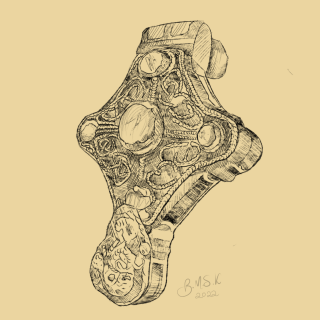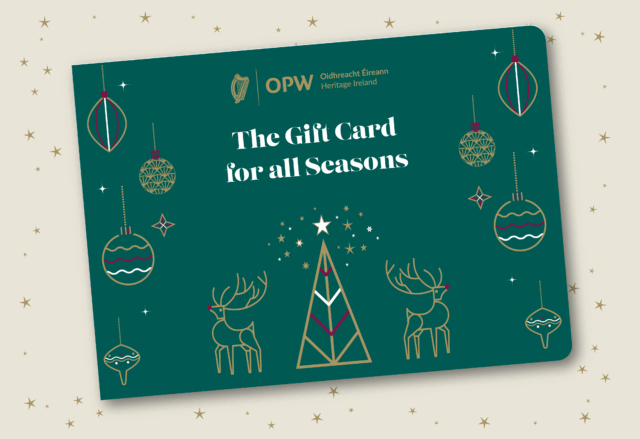
Góðan morgin*,” the girl calls to the old ostman selling bright green apples, waving, and he waves back. When he lifts his arm, a pendant catches the sunlight and glints around his neck; Thor’s hammer Mjolnir, in beaten, polished metal.
As they push through the throng, her dog goes to sniff at a stall where dried fish is being sold. He edges his head up to the wooden poles that the fish is hung from, daring to lick the side of a salted herring. The girl scolds him and pulls him away by the collar, and then apologises to the irate fisherwoman behind the stall: “Tá brón orm*.”
The market square is bustling with people hailing from both west and east of the North Sea. There are native Irish tentatively mingling with incoming Scandinavians, towns and cities filling up with ostmen, or ‘men from the east’. The girl calls her dog and they walk onwards, in through the hum of the crowd and the market, and into this new city built on the winter fjord.
She is part of a new and fast-growing cultural group appearing within Scandinavian settlements in Ireland. Her mother is an Irish freedwoman from the hills of the Déise; her father is an ostman from across the sea in Lochlann, or Norway. She is a Norse-Gael – perhaps better known as Hiberno-Norse – and thousands just like her populated the early medieval Viking towns of Waterford, Wexford, and Dublin.
Who were the Hiberno-Norse, and what impact did they have on the cultural, social, and archaeological history of Ireland?
According to the Annals of Ulster, Ireland was first introduced to these Scandinavian newcomers – more widely known as Vikings – in 795 A.D. A horde of Norwegian raiders made landfall at Rathlin Island off the coast of County Antrim, and summarily laid waste to the contemporaneous church there. The buildings were burnt to the ground and the church was pillaged for commodities like silver, slaves, and livestock. In the same year, the monks on Lambay Island in Dublin suffered a similar fate.
Being careful not to sanitise the Viking presence here too much – it’s always important to keep their violent appearance on our island in mind– one should take into account the very real and nonviolent impact that these newcomers had on the Irish once they ceased their raids and began to properly settle. There were, undoubtedly, Norse-Irish relationships, and subsequent marriages.
The Hiberno-Norse were the product of these relationships; people of mixed Irish and Norse ancestry. The group emerged in Ireland around the 9th century A.D., after the aforementioned Norse groups found their way down the Irish coast after settling in Scotland and the Isle of Man. Children of Norse and Irish parents then went on to grow up in a mixed-culture household and, more importantly, a mixed-culture society. Many were likely bilingual, speaking both Old Norse and Irish, and would have been exposed to the customs and stories of both parents’ individual cultures. It is also more likely that earlier Hiberno-Norse people had fathers from Scandinavia and mothers from Ireland, given that the majority of early Norse arrivals to Ireland were men.
This culture also gave rise to a class of in-demand mercenaries hailing from Norse-Gael clans – the gallowglass, from the Irish gallóglaigh, meaning foreign warriors.
In addition to this, the distinctive Hiberno-Norse art style began to emerge in jewellery and art, seen today in much of the archaeological finds associated with the culture, which produced fantastic craftspeople. An excellent example of this fine craftsmanship is Waterford’s kite brooch, a silver Hiberno-Norse brooch found during the excavation of the Waterford City Square Shopping Centre. The brooch itself dates back to around 1100 A.D., and is decorated with highly intricate gold filigree and amethyst-coloured glass gems.
Over time, the Hiberno-Norse people were Gaelicised to the point that their distinct culture disappeared. However, their imprint on Irish history was long-lasting, and endures today. For example, there are many areas in Ireland that still hold their Norse-Irish placenames.
– Waterford – from the Old Norse Veðrafjǫrðr; ‘winter port/port of the rams’
– Wexford – from the Old Norse Veisafjǫrðr; ‘fjord/inlet of the mud flats’
– Oxmantown, Co. Dublin – from the Old Norse Austmanna-tún; ‘Ostmantown’
– Ballygunner, Co. Waterford – from the Scandinavian name Gunnarr and the Irish baile (town); ‘the town of Gunnarr’
Additionally, there are several surnames present in the current Irish population that have Hiberno-Norse origins.
– McAuley – from the Irish Mac Amlaibh; ‘son of Amlaibh’, a Gaelicised version of Olaf.
– McAskill – from the Irish Mac Asgaill; ‘son of Asgall’, a Scandinavian given name.
– Macotter – from the Irish Mac Ottar; ‘son of Ottir’, a Scandinavian given name.
This autumn, the Office of Public Works will bring this rich culture to life by hosting a Halloween storytelling event like no other at Reginald’s Tower, Waterford; the vast Anglo-Norman successor to a Norse-built wooden watchtower constructed soon after the founding of Waterford in 914 A.D.
Sagas & Scéals is a storytelling event that will introduce visitors to Raghnailt, a Hiberno-Norse woman – complete with fully authentic costume – who will bring visitors on a storytelling adventure throughout the building. Reginald’s Tower will embrace the spookiest of seasons with pumpkins and skeletons galore, adding a ghostly ambience to the 12th-century stronghold.
Raghnailt is decidedly bilingual; she speaks both her maternal Irish and paternal Old Norse. As a child, she’ll inform visitors, her parents shared with her a myriad of stories and legends from their respective homelands, which she will then go on to recount throughout the event.
These tales include the story of Fenrir, the monstrous chained wolf of Norse mythology who, upon the advent of Ragnarok – the Old Norse doomsday – will break free from his binds and devour the sun; the medieval account of the werewolves of Osraige, the old Irish kingdom that lay in modern-day Kilkenny; the story of the horse-eared king Labraidh Loingseach; the terror of the infamous banshee; the Waterford vampire, the Dearg Dú; and many more.
The event will be aimed at giving a living personality to these distinctive people – not wholly Viking or wholly Irish, but something else entirely – and bringing to life some lesser-known myths of the Waterford area and beyond at the same time.
Details of the event and other related events can be found on the Reginald’s Tower social media pages closer to the time. Numbers limited – booking essential. Suitable for children 8+ years and above.
—————————————————————————–
*Góðan morgin = Old Norse for good morning. Phonetic: goth-an mor-gin
*Tá brón orm = Irish for I’m sorry / my apologies. Phonetic: taw brone urm


